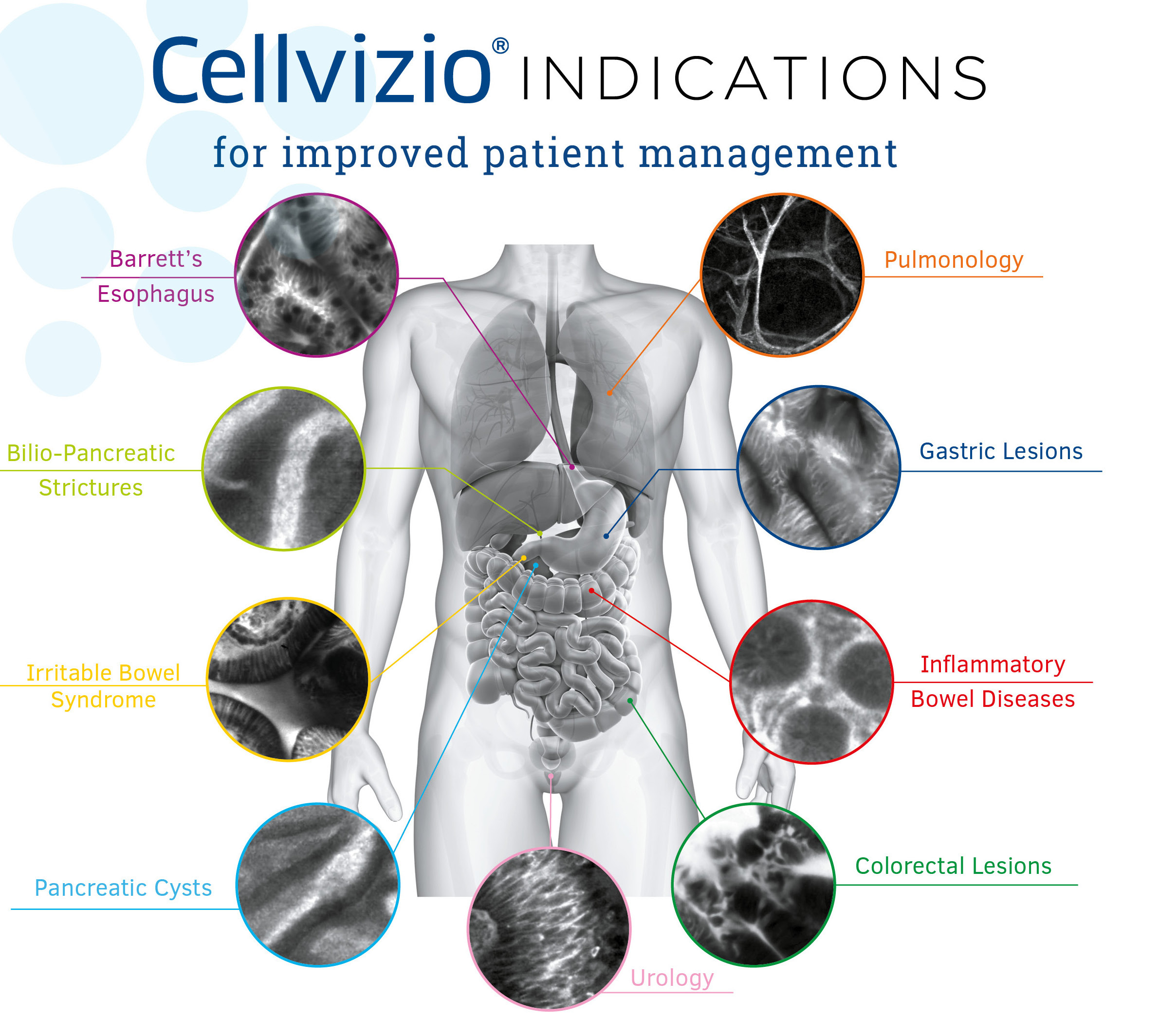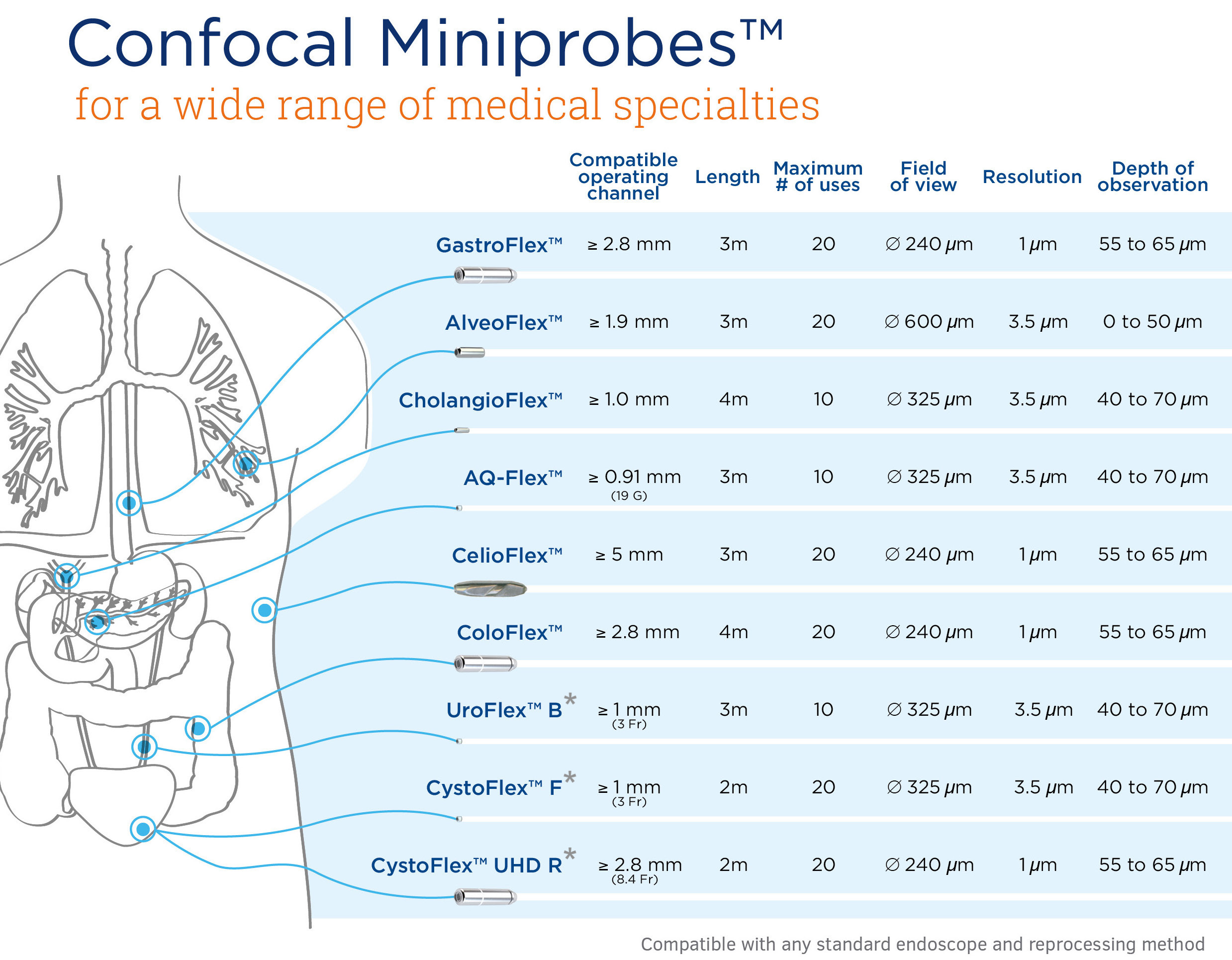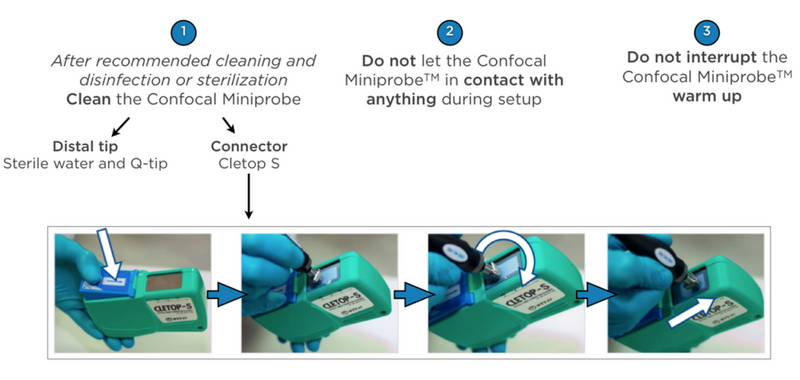- How To Use the Miniprobes?
How To Use the Miniprobes?
The information below have been extracted from the User Guide provided with the Cellvizio system and all Miniprobes. Feel free to consult them for exhaustive information.


*Urology probes only compatible with Cellvizio 100 Series at this time
Tips & tricks - Before the procedure
Basics on reprocessing
The Confocal Miniprobe™ must be reprocessed once before the first use and then between each case. Consult the instruction for use for complete information and do not re-use single use accessories as locking devices.

Reprocessing methods

The recommended reprocessing methods are described in the reprocessing user guide provided with each probe.
Preparation of the Miniprobe™

Tips & tricks - During the procedure
Apply a light contact with tissue:
1. Insert the Confocal Miniprobe™ through the operating channel
2. Feel the contact with the tissue with a light touch
3. Do not apply too much suction if using a cap
Tips & tricks - After the procedure
Extraction tool - Only for some Pentax endoscopes!
Watch the movie below to know how to use the extraction tool:
Watch the movie below to know how to use the extraction tool:
The extraction tool is intended to be used for the extraction of Confocal Miniprobes™ from the operating channel of the endoscope when the standard procedure to remove the probe from the operating channel proves to be difficult or impossible (in particular with the following types of endoscopes: Pentax EG-2990i, EG-2985k, EG-3870CIK and EC-3870CILK).
Important notice: Do not use undue force on probes during the procedure. Use only clean and disinfected extraction tool at each time. Perform a careful inspection before use of the extraction tool. Perform a careful inspection of the Confocal Miniprobe™ after extraction. Do not place the tool at 90° to the fiber bundle.
Specific instructions for Cellvizio® during an EUS-FNA procedure
Use the AQ-Flex™ 19 Miniprobe™ during an EUS-FNA procedure
Watch the movie below to learn how to pre-load the AQ-Flex™ 19 in the 19G needle:
Watch the movie below to learn how to pre-load the AQ-Flex™ 19 in the 19G needle:
The AQ-Flex™ 19 is intended to be used during EUS-FNA procedures. Once connected, the AQ-Flex™ 19 is inserted through the lumen of an endoscopic needle with a diameter greater than or equal to 0.91 mm (19 G), to provide imaging through direct contact of its distal tip with tissue.
Important notice: The use of the locking device is mandatory to lock the AQ-Flex™ 19 in the needle. Thanks to this tool, the Miniprobe™ is blocked and cannot go further than what has been prepared during the pre-loading.
The compatibility between the AQ-Flex™ 19 and the needle must be checked before the procedure thanks to the compatibility table.
Specific instructions for Cellvizio® procedures during ERCP
Use of the CholangioFlex™ Miniprobe™ during a ERCP procedure
Watch the movie below to learn how to pre-load the CholangioFlex™ in the ERCP catheter and how to use it:
Watch the movie below to learn how to pre-load the CholangioFlex™ in the ERCP catheter and how to use it:
The CholangioFlex™ Miniprobe™ is intended to be used during ERCP. Once connected, the CholangioFlex™ is inserted through the lumen of an endoscope or a catheter designed for biliary and pancreatic ducts, with an operating channel or lumen internal diameter higher or equal to 1.0 mm, to provide imaging through direct contact of its distal tip with tissue.
Important notice: The compatibility between the catheter and the CholangioFlex™ must be checked before the procedure thanks to the compatibility table.
Specific instructions for Cellvizio® procedures during EBUS-TBNA
Use the AQ-Flex™ 19 Miniprobe™ during an EBUS-TBNA procedure
Watch the movie below to learn how to pre-load the AQ-Flex™ 19 in the 18G needle:
Watch the movie below to learn how to pre-load the AQ-Flex™ 19 in the 18G needle:
The AQ-Flex™ 19 is intended to be used during EBUS-TBNA procedures. Once connected, the AQ-Flex™ 19 is inserted through the lumen of an endoscopic needle with a diameter greater than or equal to 0.91 mm (18 G), to provide imaging through direct contact of its distal tip with tissue.
Indications for use:
Cellvizio 100 series and I.V.E Systems with Confocal Miniprobes™ are regulated Medical Device, CE marked (CE 0459) (Class IIa - NB : G-MED) and FDA cleared. Cellvizio is a registered trademark and Confocal Miniprobe™ is a trademark of Mauna Kea Technologies. The Cellvizio 100 series and I.V.E are confocal laser systems with fiber optic probes that are intended to allow imaging of the internal microstructure of tissues including, but not limited to, the identification of cells and vessels and their organization or architecture.
Once connected to the Cellvizio I.V.E. system:
The ColoFlex™ N and GastroFlex™ N Confocal Miniprobes™ are intended to allow imaging of anatomical tracts, i.e. gastrointestinal systems, accessed by an endoscope or endoscopic accessories.
The CholangioFlex™ N Confocal Miniprobes™ are intended to allow imaging of the upper gastrointestinal tract including biliary and pancreatic ducts accessed by an endoscope or endoscopic accessories.
The AlveoFlex™ N Confocal Miniprobes™ are intended to allow imaging of anatomical tracts, i.e. the respiratory system accessed by an endoscope or endoscopic accessories.
The CelioFlex™ 5 N of Confocal Miniprobes™ are intended to provide visualization of body cavities, organs, and canals during endoscopic and laparoscopic surgical procedures, including robot-assisted procedures.
US clearance:
The AQFlex™ 19 N Confocal Miniprobes™ are intended to allow imaging of anatomical tracts, i.e., gastrointestinal and respiratory tracts, accessed by an endoscope, or endoscopic accessories (e.g. aspiration needles used during procedures including EUS-FNA, EBUS-TBNA and TBNA needles).
CE marked:
The AQ-Flex™ 19 N Confocal Miniprobes™ are intended to allow imaging of anatomical tracts, i.e., gastrointestinal tracts and respiratory tracts accessed by an endoscope or endoscopic accessories, including through endoscopic needles.
The AQ-Flex™ 19 IR N Confocal Miniprobes™ are intended to provide visualisation of body cavities, organs, and canals, accessed by accessories used during interventional radiology procedures including, but not limited to catheters, endoscopic needles, coaxial needles and trocars.
Once connected to the Cellvizio 100 Series system:
The GastroFlex™ UHD and ColoFlex™ UHD Confocal Miniprobes™ are intended to allow imaging of anatomical tracts, i.e., gastrointestinal systems, accessed by an endoscope or endoscopic accessories.
The AlveoFlex™ Confocal Miniprobes™ are intended to allow imaging of anatomical tracts, i.e., respiratory systems, accessed by an endoscope or endoscopic accessories. The CholangioFlex™ series of Confocal Miniprobes™ are intended to allow imaging of the upper gastrointestinal tract including biliary and pancreatic ducts, accessed by an endoscope or endoscopic accessories.
US clearance:
The AQ-Flex™ 19 Confocal Miniprobes™ are intended to allow imaging of anatomical tracts, i.e., gastrointestinal and respiratory tracts, accessed by an endoscope, or endoscopic accessories (e.g. aspiration needles used during procedures including EUS-FNA, EBUS-TBNA and TBNA needles).
CE marked:
The AQ-Flex™ 19 Confocal Miniprobes™ are intended to allow imaging of anatomical tracts, i.e., gastrointestinal tracts and respiratory tracts accessed by an endoscope or endoscopic accessories, including through endoscopic needles.
The AQ-Flex™ 19 IR Confocal Miniprobes™ are intended to provide visualisation of body cavities, organs, and canals, accessed by accessories used during interventional radiology procedures including, but not limited to catheters, endoscopic needles, coaxial needles and trocars.
The CystoFlex™ (F, UHD R) and Uroflex™ B of Confocal Miniprobes™ are intended to allow imaging of anatomical tracts, i.e., urinary, including, but not limited to, urethra, bladder, and ureter, accessed through an endoscope or endoscopic accessories.
The CelioFlex™ UHD 5 of Confocal Miniprobes™ are intended to provide visualization of body cavities, organs, and canals during endoscopic and laparoscopic surgical procedures, including robot-assisted procedures.
Please consult labels and instructions for use. These statements have not been reviewed, cleared, or approved by the U.S. FDA. The use of this medical device is exclusively reserved for health professionals. Product availability cannot be guaranteed in all countries. For further information, please contact your local sales representative.
